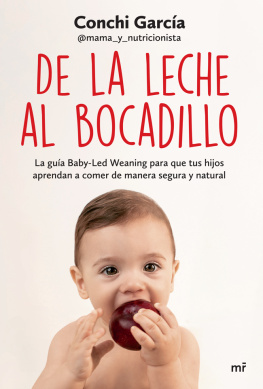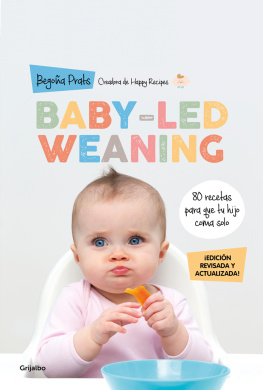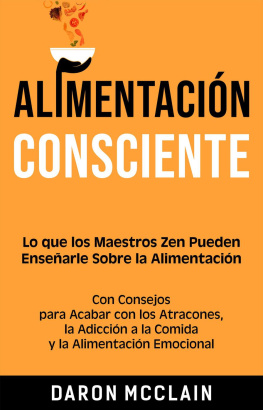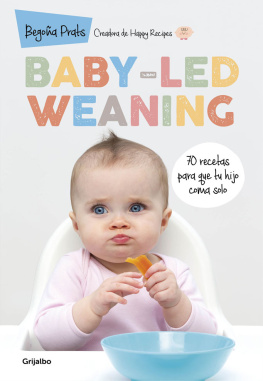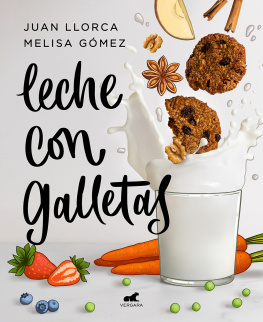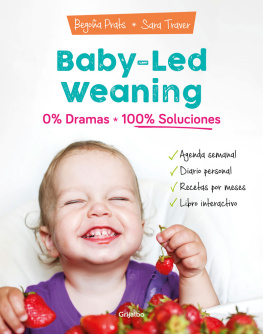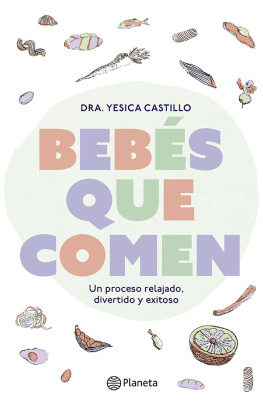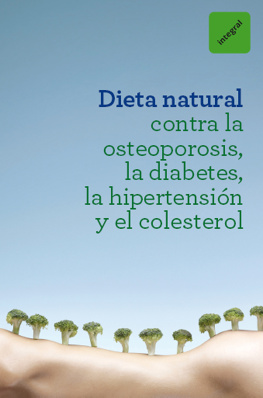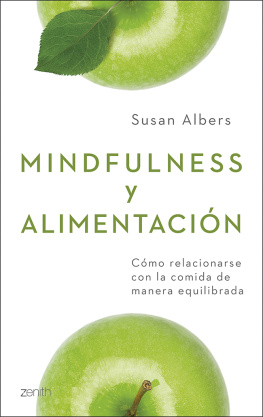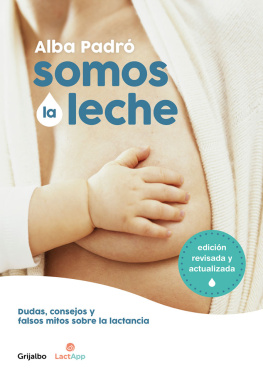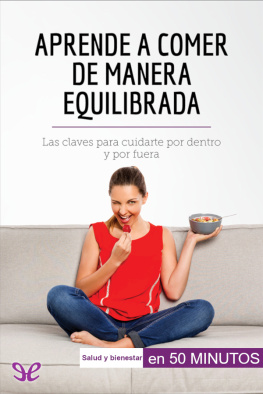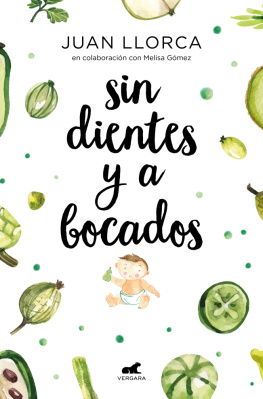A Isabel por contactar conmigo aquel 29 de agosto y al resto del equipo de Planeta: Virginia, Pepa y Teresa.
A Yaiza Cuba, por su aportación desinteresada.
A mis padres, por apoyarme siempre y animarme a estudiar lo que hoy es mi pasión.
A Aitor, mi marido, por ser cómplice de mis locuras y ayudarme a cumplir mi sueño. Sin ti no hubiera sido posible.
INTRODUCCIÓN
OMS. La alimentación del lactante y del niño pequeño. Capítulo Modelo para libros de texto dirigidos a estudiantes de medicina y otras ciencias de la salud. 2010.
Schwartz C., Scholtens P. A., et al. «Development of healthy eating habits early in life. Review of recent evidence and selected guidelines». Appetite. 2011 Dec; 57(3):796-807.
Nicklaus S. «The role of food experiences during early childhood in food pleasure learning». Appetite. 2016. Sep 1; 104:3-9.
Mennella J. A., Bobowski N. K. «The sweetness and bitterness of childhood: Insights from basic research on taste preferences». Physiol Behav. 2015 Dec; 1; 152(Pt B):502-507.
https://www.aesan.gob.es/AECOSAN/docs/documentos/nutricion/observatorio/Informe_Aladino_2019.pdf
NCD Risk Factor Collaboration. «Trends in adult body-mass index in 200 countries from 1975 to 2014: a pooled analysis of 1698 population-based measurement studies with 19·2 million participants». Lancet. 2016 Apr; 2; 387(10026):1377-1396.
PRINCIPIOS BÁSICOS
1. BREVE HISTORIA DE LA ALIMENTACIÓN INFANTIL AUTORREGULADA
OMS. Guiding principles for complementary feeding of the breastfed child. 2001.
Schwartz C., Scholtens P. A., et al. «Development of healthy eating habits early in life. Review of recent evidence and selected guidelines». Appetite. 2011 Dec; 57(3):796-807.
Davis C. M. «Results of the self-selection of diets by young children». Can Med Assoc J. 1939 Sep; 41(3):257-261.
Asamblea mundial OMS, documento 54. Estrategia mundial para la alimentación del lactante y del niño pequeño. Duración óptima de la lactacia exclusiva. 2001.
Rapley, G., Murkett T. Helping your baby love good food. Vermilion. Londres. 2008.
2. QUÉ ES EL BLW
Rapley, G., Murkett T. Helping your baby love good food. Vermilion. Londres. 2008.
https://www.aeped.es/sites/default/files/documentos/recomendaciones_aep_sobre_alimentacio_n_complementaria_nov2018_v3_final.pdf
3. BENEFICIOS E INCONVENIENTES DEL BLW
Brown A., Jones S. W., et al. «Baby-Led Weaning: The Evidence to Date». Curr Nutr Rep. 2017; 6(2):148-156.
Arden M. A., Abbott R. L. «Experiences of baby-led weaning: trust, control and renegotiation». Matern Child Nutr. 2015 Oct; 11(4):829-844.
Taylor R. W., Williams S. M., et al. «Effect of a Baby-Led Approach to Complementary Feeding on Infant Growth and Overweight: A Randomized Clinical Trial». JAMA Pediatr. 2017 Sep 1; 171(9):838-846.
Birch L. L., Doub A. E. «Learning to eat: birth to age 2 y». Am J Clin Nutr. 2014 Mar; 99(3):723S-728S.
Harrison M. E., Norris M. L., et al. «Systematic review of the effects of family meal frequency on psychosocial outcomes in youth». Can Fam Physician. 2015 Feb; 61(2):e96-106.
Fewtrell M., Bronsky J., et al. «Complementary Feeding: A Position Paper by the European Society for Paediatric Gastroenterology, Hepatology, and Nutrition (ESPGHAN) Committee on Nutrition». J Pediatr Gastroenterol Nutr. 2017 Jan; 64(1):119-132.
Issanchou S., Consortium H. «Determining Factors and Critical Periods in the Formation of Eating Habits: Results from the Habeat Project». Ann Nutr Metab. 2017; 70(3):251-256.
Nicklaus S. «The Role of Dietary Experience in the Development of Eating Behavior during the First Years of Life». Ann Nutr Metab. 2017; 70(3):241-245.
Harris G., Coulthard H. «Early Eating Behaviours and Food Acceptance Revisited: Breastfeeding and Introduction of Complementary Foods as Predictive of Food Acceptance». Curr Obes Rep. 2016 Mar; 5(1):113-120.
Nicklaus S. «Complementary Feeding Strategies to Facilitate Acceptance of Fruits and Vegetables: A Narrative Review of the Literature». Int J Environ Res Public Health. 2016; 13(11):1160.
http://www.sedo.es/blog/200-la-importancia-de-la-prevención-en-la-ortodoncia.html
4. BLW Y HIERRO
Daniels L., Heath A. L., et al. «Baby-Led Introduction to SolidS (BLISS) study: a randomised controlled trial of a baby-led approach to complementary feeding». BMC Pediatr. 2015 Nov 12; 15:179.
https://data.worldbank.org/indicator/SH.ANM.CHLD.ZS
Baker R. D., Committee on Nutrition AAP, et al. «Diagnosis and prevention of iron deficiency and iron-deficiency anemia in infants and young children (0-3 years of age)». Pediatrics. 2010 Nov; 126(5):1040-1050.
Chaparro C. M. «Setting the stage for child health and development: prevention of iron deficiency in early infancy». J Nutr. 2008 Dec; 138(12):2529-2533.
Fewtrell M., Bronsky J., et al. «Complementary Feeding: A Position Paper by the European Society for Paediatric Gastroenterology, Hepatology, and Nutrition (ESPGHAN) Committee on Nutrition». J Pediatr Gastroenterol Nutr. 2017 Jan; 64(1):119-132.
https://www.paho.org/Spanish/AD/FCH/NU/FRM03_HierroGuias.pdf
Daniels L., Taylor R. W., et al. «Impact of a modified version of baby-led weaning on iron intake and status: a randomised controlled trial». BMJ Open. 2018 Jun 27; 8(6):e019036.
OMS. Delayed umbilical cord clamping for improved maternal and infant health and nutrition outcomes. 2014.
5. BLW Y ATRAGANTAMIENTOS
Spencer B., Wambach K. «Breastfeeding and Human Lactation». Jones and Banett Publishers. Massachusetts, 2010.
https://efsa.onlinelibrary.wiley.com/doi/epdf/10.2903/j.efsa.2013.3408
EFSA. Age to start complementary feeding of infants. 2019.
https://www.aap.org/en-us/advocacy-and-policy/aap-health-initiatives/HALF-Implementation-Guide/Age-Specific-Content/Pages/Infant-Food-and-Feeding.aspx
Fangupo L. J., Heath A. M., et al. «A Baby-Led Approach to Eating Solids and Risk of Choking». Pediatrics. 2016 Oct; 138(4):e20160772.
https://medlineplus.gov/spanish/ency/article/000048.htm
Meyli M., Chapin M., et al. «Nonfatal Choking on Food Among Children 14 Years or Younger in the United States, 2001-2009». Pediatrics. 2013 Aug, 132 (2) 275-281.
https://www.healthychildren.org/Spanish/health-issues/injuries-emergencies/Paginas/choking-prevention.aspx
Dogan E., Yilmaz G., et al. «Baby-led complementary feeding: Randomized controlled study». Pediatr Int. 2018 Dec; 60(12):1073-1080.
https://www.aeped.es/sites/default/files/documentos/recomendaciones_aep_sobre_alimentacio_n_complementaria_nov2018_v3_final.pdf
6. ¿COMERÁ SUFICIENTE?
Orrell-Valente J. K., Hill L. G., et al. «“Just three more bites”: an observational analysis of parents’ socialization of children’s eating at mealtime». Appetite. 2007 Jan; 48(1):37-45.
Turner L., Chriqui J. F., et al. «Food as a reward in the classroom: school district policies are associated with practices in US public elementary schools». J Acad Nutr Diet. 2012 Sep; 112(9):1436-1442.
Taylor R. W., Williams S. M., et al. «Effect of a Baby-Led Approach to Complementary Feeding on Infant Growth and Overweight: A Randomized Clinical Trial».

